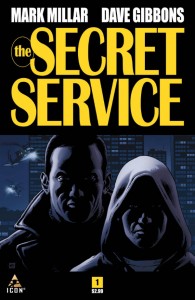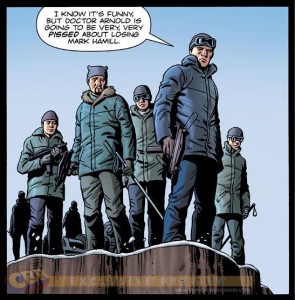 EDITOR’S NOTE: If spoiled, the Director will disavow any knowledge of your actions.
EDITOR’S NOTE: If spoiled, the Director will disavow any knowledge of your actions.
I’m going to get the unpleasantness out of the way up front and recommend that, if you’re interested in reading Mark Millar’s and Dave Gibbons’s The Secret Service, you just skip the first issue of and think about picking it up when the entire story is collected into a trade. Because there’s a glimmer of a decent and potentially fun idea in this issue which might make it eventually worth reading, but it is wrapped up here in a gaggle of thoroughly unlikable characters, derivative plot points, and shock value slapstick violence. It is like watching an episode of Springer where Jerry hands out .44 Magnums; there is a certain level of entertainment value to the spectacle, but of the kind you would never admit to strangers.
The high concept behind this book is: what if James Bond was a real thing in the real world? Which is fine as these things go, but it put into stark relief the kind of comic books that Mark Millar writes when it’s something he owns: books that can be distilled down to the kind of elevator pitch one would make to Michael Bay, possibly while sharing a couple of rails.
Let’s go down the list:
- Wanted: What if there were supervillains, but no superheroes?
- Kick-Ass: What if superheroes were a real thing in the real world?
- Superior: What if Captain Marvel was a real thing in the real world?
- Nemesis: What if Batman was a bad guy?
- Super Crooks: GOTO 10
This is the diametric opposite of the “Big Idea” comics that are the stock in trade of Millar’s former mentor, Grant Morrison. They are Small Idea comics, in the strictest and truest sense of the phrase: the only way the concepts from which Millar constructs these comics could be shrunk would be to start yanking out conjunctions, adjectives and pronouns (“Batman: bad?”). All of which makes it somewhat ironic that Millar yanks the sequence in which we meet one of our presumed protagonists nearly whole cloth from the first issue of Morrison’s Big Idea-laden The Invisibles, but we’ll get to that in a minute.
Millar tends to mask the fact that his creator-owned stuff can be broken down to a one-sentence question that Vern Tessio might ask Gordie LaChance to break the monotony of walking to go see a body by stocking it with barely-likeable, “realistic” characters who engage in bloody cartoon violence, and then he starts mewling in public for a movie option check. And hey – there’s nothing wrong with writing a comic book that can be turned into an action movie. I like comic book movies. But it has reached the point where reading a Mark Millar comic makes me feel like a member of a focus group for Paramount Pictures… a focus group with no free muffins and coffee, and that I had to pay three bucks to be a part of.
But this is, ostensibly at least, a review of The Secret Service #1, not Mark Millar’s ancillary sources of income. And Millar’s idea of what James Bond would be like if he was a real thing in the real world includes botched rescues due to ineffective equipment bought from the lowest bidder. We open with a scene where a Bond analogue tries to rescue a kidnapped Mark Hamill (You heard me) in a classic Bondian snowmobile / armed skiers alpine chase (Why is it that whenever someone tries to elicit a Bond feel, they immediately lock on The Spy Who Loved Me and For Your Eyes Only? Has Roger Moore scarred that many people?) which goes wrong when a Bond (again) classic Union Jack parachute fails to open. This scene is actually somewhat effective; in the course of a page, Millar turns around a standard Bond (Gahh!) story trope into cartoon slapstick. The only thing it was missing was Hamill holding up an “UH-OH!” sign an instant before plummeting off the cliff.
 We later discover that someone is kidnapping the stars of Star Wars, Doctor Who and Star Trek… which leads to the obvious question: why kidnap Mark Hamill instead of Harrison Ford? And the only answer I can come up with is that Millar knows that Ford would never agree to do a guest spot in his movie adaptation. Which brings into stark relief the problem with Millar’s penchant for treating his comics like storyboards for a movie pitch meeting: I’m starting to notice the man behind the curtain waving his arms and screaming for an option check. And when I do, it drags me out of the book.
We later discover that someone is kidnapping the stars of Star Wars, Doctor Who and Star Trek… which leads to the obvious question: why kidnap Mark Hamill instead of Harrison Ford? And the only answer I can come up with is that Millar knows that Ford would never agree to do a guest spot in his movie adaptation. Which brings into stark relief the problem with Millar’s penchant for treating his comics like storyboards for a movie pitch meeting: I’m starting to notice the man behind the curtain waving his arms and screaming for an option check. And when I do, it drags me out of the book.
We soon meet our protagonists: British Secret Service agent Jack London (probably because “Benny Britain” would be a little on the nose) and his nephew Gary. We meet Gary through his family – a thoroughly detestable lot of drunken, unemployed weed smokers who take enjoyment from having children roll joints for them in between mild constitutionals of domestic violence, domestic battery and (potentially… probably) public buggery. These are detestable people; the kind of people that several presidential candidates wish actually existed in order to justify taxing Bumfights videos or some other spastic political scheme.
They’re the kind of characters that most writers would use as a foil to demonstrate Gary’s basic, innate decency… so Millar has Gary immediately steal a car with his friends, who are also a bunch of irritating and foulmouthed Yobbos or Chavs or whatever the fuck English people call douchebags these days. It would be a bold choice to use this method to introduce who will inevitably wind up being one of the “heroes” of the story… except Grant Morrison used almost exactly the same scene to introduce us to Dane in The Invisibles. All the elements are there, from the detestable, whorish mother driving Gary / Dane out (After refusing to give him money for a movie, no less) to the stolen car to the Yobbos to the incident leading to a meeting with an English super secret agent. The parallels are jarring; any sequence that drives you to put down a comic book and hunt up your Invisibles: Say You Want A Revolution trade paperback to see if the comic has driven you literally insane is simply not working. It would have been less distracting if Millar had opened the book with Mark Hamill blowing up the Death Star, or even with Mark Hamill blowing Harrison Ford.
By far and away the best part of this comic book is Dave Gibbons’s art. His style here is the same as it ever was; if you’ve read Watchmen or his Martha Washington books, you know what you’ll be getting here: clean, realistic figures with highly expressive faces, and clean, easy-to-follow panel layouts for simple storytelling and controlled pacing – Gibbons makes that snowmobile cliff fall take forever, and he mixes the bloody horror and goofy humor masterfully. The only problem I’ve seen is that every time Gibbons draws an earnest, chubby dude at a distance (Hi, Mark Hamill!), that dude winds up looking like Nite Owl.
I get that this has been a long review, and it’s safe to say that if you’ve made it this far, it’s pretty clear that I’m not recommending The Secret Service. It’s simplistic, it’s derivative, and so far there’s no one in the book to bother liking. However, the glimmer of an idea of James Bond trying to be James Bond on a budget is still interesting, if currently buried in a bunch of too-clever cameos, lifted scenes and Yobbos, so it’s possible this thing might turn itself around once it’s collected.
With that said, lets not kid ourselves: this is a comic book based on a simplistic idea that was born not to be a good comic book, but to sell an action movie property – Millar baldly states that his Hollywood buddy, Kick-Ass (“Kick-Ass” itialicized to denote a title, not that the buddy literally kicks ass) director Matthew Vaughn, is already working on a screenplay. And while there isn’t anything wrong with pitching an original action flick, ask yourself: what was the last big-budget original action movie you saw that was any fucking good?
Exactly.
(Image via Comic Book Resources)
 Podcast RSS Feed
Podcast RSS Feed iTunes
iTunes Google Play
Google Play Stitcher
Stitcher TuneIn Radio
TuneIn Radio Android
Android Miro Media Player
Miro Media Player Comics Podcast Network
Comics Podcast Network